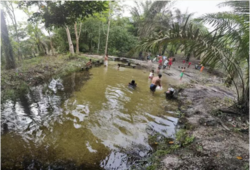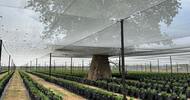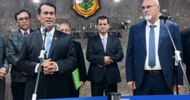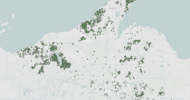
Indigenous elders from Pantai Cermin village together with people from KRuHA and Litoral joining the online discussion. Photo: YMI
From Asia to Africa: Tentacles of oil palm plantations are squeezing communities dry
by GRAIN and KRuHA (Indonesia)
There is no other crop that has grown faster globally in the last decade than palm oil. This almost uncontrollable expansion leaves a deep trail of destruction and conflicts around its giant areas of plantations from Southeast Asia to West and Central Africa. As companies take over more community land, they also grab the water sources from them.
There are no other commodity crops that have grown faster globally in the last decade than palm oil. Vegetable oil production increased 118 per cent in the last ten years alone, the majority of it is driven by the sharp increase in palm oil production. (1) In its epicentre of production, in Indonesia, the area of oil palm plantations is doubling every decade and now has reached more than 15 million hectares. This almost uncontrollable expansion leaves a long trail of destruction and conflicts with it, taking up huge chunks of arable land, pristine rainforests, indigenous forest territories, biodiversity and a limited essential resource that is getting more scarce in the face of the climate crisis: water.
The palm oil industry in Indonesia is a legacy of the colonial era. Since colonialism, Indonesia has been the world’s core site of extraction and part of the geography of the global capitalist division of labour. (2) The archipelago has become a supplier of leading commodities in the world market, from minerals to (forced) plantation products. Indonesia has followed and developed the concession capitalism model, which is based on contracts awarded by governments to investors, both for infrastructure projects and for extractive industries’ needs. This model has continued in the post-colonial era in order to maintain and facilitate the extractive industries and the expansion of oil palm plantations.
However, as the land for plantations becomes scarce, the palm oil industry needs to expand its business further into other regions. This industry continues to expand its giant areas of plantations to annex and control more people's lands from Southeast Asia to West and Central Africa.
As companies take over community territories, they also grab the water source from them. People who are living inside and around the plantations are struggling to access the quantity and quality of water needed for daily needs: drinking, cooking, bathing, and growing food. Besides, they are also losing important sources of food: the fish in the rivers and lakes that are being contaminated by the agrotoxics used in the plantations.
In this background, communities and civil society organizations from Indonesia, Gabon and Cameroon came together on the World Water Day (22 March) to share their experiences facing industrial oil palm plantations and to assert their rights to water.
Losing access to water: The case in Riau and West Kalimantan, Indonesia
Many Indigenous communities in Indonesia are river-dependent people. Rivers are their lifeblood. It is the source of their livelihood, clean water resources and an important place where ritual or customary ceremonies are held. But now, communities and Indigenous Peoples have to face the loss of the rivers and tributaries that are their source of life.
Expansion of oil palm plantations affects the sustainability of rivers in different ways. Plantations straighten, move, and bury rivers and tributaries with the aim of expediting water flows. These actions increase sedimentation, decline water quality, and accelerate flooding.
Of course, these impacts affect the communities. Sedimentation destroys specific habitats of high value fishes, such as Tapah (freshwater catfish), and declines other fish populations and species. The number of fishing areas is shrinking and this has compelled fisherfolks to travel long distances, which increases their expenses on fuel and others. In the Riau province, which has the largest palm oil plantation concession in Indonesia, the last Pantai Cermin fisherfolks said that they are only able to catch less than 1 kg of fish every two to three days nowadays. Many villagers can no longer depend on their income from fishing and consider it a side job or just a hobby.
Another experience shared by the community from West Kalimantan is that, in the past, they could predict things like, for example, the flood cycles once a year or the big floods every five to ten years. But now, flash floods cannot be predicted and the intensity and frequency of the floods are also increasing. Fisherfolk families such as those from the Semanga or Sambas district, West Kalimantan, used to benefit from the flood seasons because it allowed them to catch more fish, even 20 kg of freshwater giant river prawn per day. But nowadays, after their villages are surrounded by oil palm plantations, they no longer can benefit from the floods. The fish population has decreased tremendously due to the loss of their habitats as well as the declining water quality because of sedimentation and pollution from the plantations. The increase of the floods has also affected most rubber tapper households who lose their income during the floods. The rain-fed rice field along the riverbank has also flooded more frequently, resulting in harvest failure.
Research by Indonesian civil society organisations, People’s Coalition for the Right to Water (KRuHA), and, Litoral, confirms this impact. Two villages living in the Riau province, upstream of the Siak watershed, around the plantation of one of WILMAR subsidiary, PT Egasuti Nasakti, found in 2022 that the company is planting oil palms in the riparian buffer zone or next to water bodies. This practice increases fertilizer and pesticide contamination runoff to the river which declines the water quality. The polluted river increases people’s dependency on groundwater for clean water needs. But the groundwater quality is also not acceptable as drinking water. This is due to high phosphate concentration from fertilizers, which exceeds the acceptable limit. In addition, more than 87 per cent of groundwater samples exceed hexavalent chromium (Cr(VI)). Heavy metals such as lead, chromium, and mercury, which are generally present in fertilizers and pesticides, are well known for causing toxicity to human health and pollute the environment.
“In the past, our livelihood was made up of fishing; most of our people worked as fisherfolks. But a few years after the palm oil came in, our river was polluted. We can no longer catch fish. We also used to drink water from the river, but now it's hard to even take a bath because it's been polluted by the plantations. Once a year, large amounts of waste from plantations and processing factories are dumped into rivers. In the past, there were many tributaries that flowed into the Tapung river, but now many have dried off, buried, or straightened (meaning the dredging or scraping and leveling of the riverbank area so that the company can plant more). Now we only remember the name of the tributary, but its flow is no longer there. We are using wells to meet our water needs, although now we have to deepen them by several tens of meters. The water that we usually get is five or six meters deep. Now we have to drill a minimum of twenty-five meters to get the water.” said Datuk Bathin Sigale, one of the Indigenous elders from Pantai Cermin village in Riau.
Replicating destruction: Stories from Gabon and Cameroon
In the past several years, companies that have caused destruction for decades in Southeast Asian countries, like in Indonesia and Malaysia, have been actively expanding their plantation areas to Western and Central Africa, where oil palm trees originally come from. One such company is OLAM, a Singapore-based food and agri-business company. OLAM Palm Gabon is a joint venture with the Gabonese government and has planted over 60,000 hectares of oil palm plantations in the country.
Ladislas Desire Ndembet from Gabon-based environmental group, Muyissi Environnement, who has dealt with the impact of oil palm plantations in the country, said that they shared a similar situation with communities in Indonesia. In Gabon, companies like OLAM dispossessed lands and contaminated the water of Iroungou river at Moutassou Lot 3. OLAM’s goal to establish in Gabon the largest oil palm plantation in Africa comes with a high price for communities.
OLAM is setting up a drip irrigation system for their plantations, for which
they take a huge amount of water from the rivers. This certainly affects the water sources of the people living in the vicinity of the plantations. This is a serious challenge in a context of many already great difficulties to access drinking water across the country. People have to dig deep wells to get water. In the area of the village Sanga, Muyissi found that the water was already contaminated by glyphosate, which has been banned in many countries due to its high toxicity. Yet, it is still heavily used in many oil palm plantations, including those from OLAM in Gabon for herbicide control. This heavily affects the health of men and women living around the plantation.
Meanwhile, Emmanuel Elong, president of SYNAPARCAM, a Cameroonian organisation defending the rights of communities, shared how communities living around Socfin/Bollore plantations have to use water contaminated with pesticides and other chemicals for daily consumption. “So many people are getting sick because of this”, affirmed Elong. However, the government does nothing about this problem. Through a vast network of holdings and operational companies, Socfin controls about 400,000 hectares of land concessions in ten countries, including over 73,000 hectares in Cameroon. Half of that land area is currently covered with industrial plantations.
Most communities in Cameroun do not have access to safe drinking water. Even when the communities affected by Socfin tried to drill a well, water was still hard to come by. The community finally had to wait a week to get water assistance. But these problems have been going on for years. Communities are now also protesting against the RSPO certification awarded to Socfin’s subsidiary in Cameroon - Socapalm in Mbongo and Mbambou districts and Safacam in the district of Dizangue. People receive water from Socapalm’s tank tractors in uncontrolled frequencies. The company does not comply with various social and environmental criteria established by the certifier itself, yet, they were granted the stamp, which helps the company to access more markets and greenwash its activities.
Connecting the struggles…
Both communities and activists from Indonesia, Gabon, and Cameroon, acknowledged that there is a need to build a stronger and active solidarity among communities against industrial plantations. There is a need to learn from each other and exchange experiences and knowledge at the grassroots level to fight the ever-expanding oil palm plantations.
Facing the same problems and territorial occupation by multinational companies like WILMAR, OLAM, Socfin and others, that have threatened their livelihoods and communities, they understand these companies are in the search to fulfil their unquenchable thirst to profit from palm oil.
The sharing of communities’ experiences also shows the importance to connect the fight for land and water in the movement against oil palm expansion. The problem lies in the model of industrial monoculture plantations, which devastates soils, diversity, local livelihoods and water sources.
With land grabbing, there is also water grabbing. The latter is not only about direct water grabbing, but also about the grabbing of basic rights for accessible clean water of communities and plantation workers. The pollution from the high doses of chemical fertilisers and agrotoxins used in industrial plantations is poisoning many water sources and thus, all life that exist in these territories.
-
(1) FAO, ‘Statistical yearbook 2021: production, trade and prices of commodities’.
(2) Batubara, Bosman dan Noer Fauzi Rachman. 2022. “Extended Agrarian Question in Concessionary Capitalism: The Jakarta’s Kaum Miskin Kota.” Agrarian South: Journal of Political Economy 1–24. Centre for Agrarian Research and Education for South (CARES).













